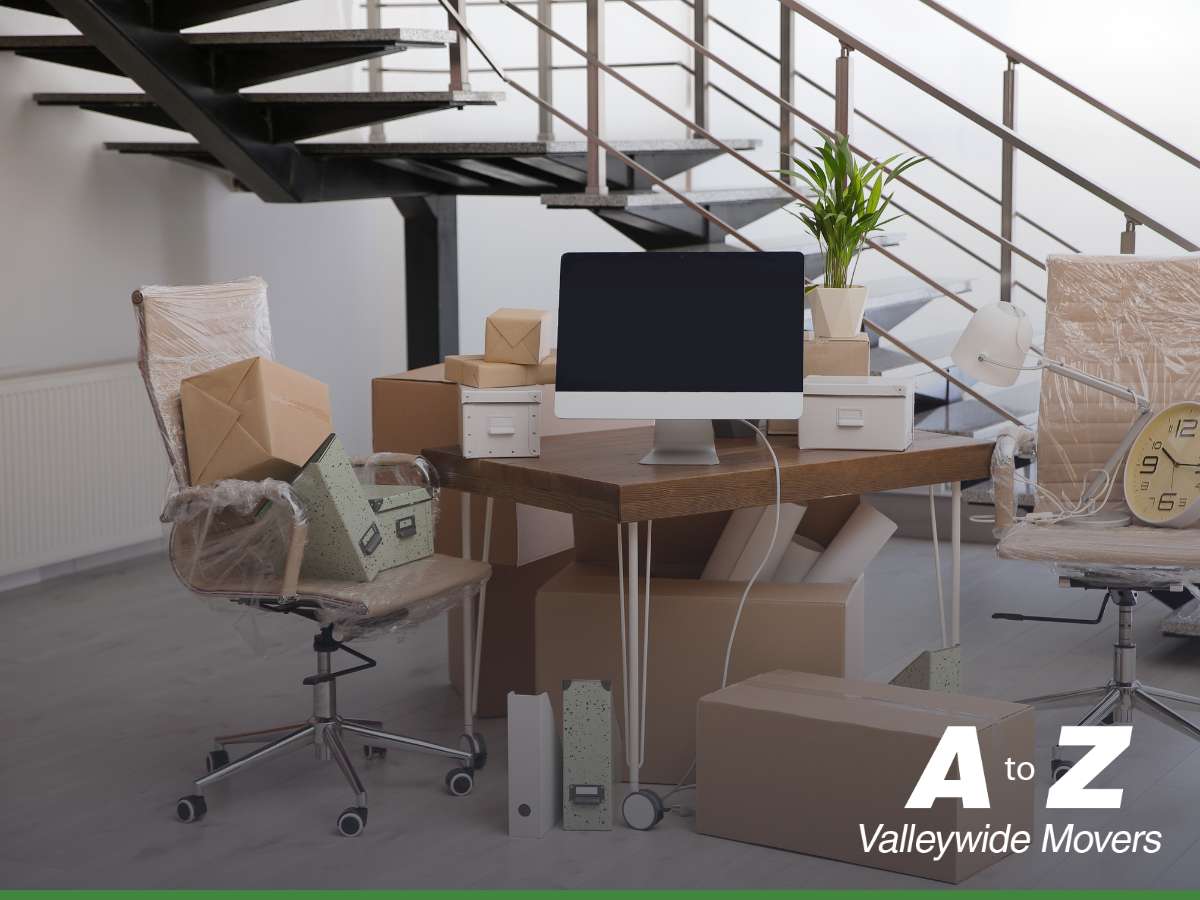What Planning Should Precede a Corporate Office Move?
Essential Steps & Key Considerations For a Successful Corporate Office Relocation
Planning a corporate office move is a difficult and delicate task for anyone. That’s why ensuring proper planning is so crucial, as it’s the key to achieving a successful transition without disrupting productivity.
But what steps should this planning have? How exactly should you plan your move?
That’s what our Gilbert company is ready to answer in the following guide. We’ll explain the critical steps and considerations to prepare effectively for a corporate office relocation.

How To Define The Purpose Of Your Corporate Office Move
Understanding the primary reasons for the move helps align the entire planning process. Common reasons include expansion, downsizing, improving location, or enhancing office amenities.
We recommend defining the purpose clearly to ensure all planning efforts are directed towards achieving the desired outcomes, whether it’s optimizing space utilization or improving employee morale.
But don’t focus only on a main purpose that could be too unrealistic. The best you can do is to establish small key goals to achieve that purpose, meaning that you have to define what the company aims to achieve through the move with small steps. This might include increased space, improved facilities, or a better location.
Setting clear, measurable goals helps keep the project on track and provides benchmarks to assess the move’s success. Goals should be specific, achievable, relevant, and time-bound to ensure the company meets them effectively.
Creating a Realistic Budget & Timeline For Your Relocation
A detailed timeline and budget is crucial for a successful move. Otherwise, your company could face sudden emergencies that require a lot of money.
When creating the timeline, remember to include all stages of the move, from initial planning to post-move activities. It is essential to assign deadlines to each task to ensure timely completion.
Break down the timeline into manageable phases, such as pre-move planning, packing, the actual move, and post-move setup, to maintain a clear overview of the process.
Key milestones such as lease signing, notifying stakeholders, and the physical move date should be clearly marked on the timeline. These milestones help monitor progress and ensure the move stays on schedule. Moreover, you should review these milestones often to make adjustments when necessary.
As for the budget, we always recommend creating a detailed one that helps you avoid unexpected expenses. Include all potential costs such as commercial moving services, packing materials, insurance, and new office setup. A well-planned budget should account for all aspects of the move, from the initial planning stages to the final setup in the new location.
Unexpected costs are almost inevitable. That’s when contingency funds become a must, as they ensure the project can handle unforeseen expenses without financial strain.
Typically, setting aside 10-15% of the total budget for contingencies provides a buffer for unexpected costs, such as last-minute changes or additional packing materials.
Research & Choose The Right Movers
Research different movers in Gilbert to choose the right one for your relocation. Consider factors like experience, services offered, and customer reviews. Look for companies with experience in corporate moves and positive feedback from previous clients to ensure they can handle the complexity of the task.
Select The Best Location For Your Corporate Office Move
Choosing the right location for your office is crucial because it impacts employee satisfaction, client accessibility, and overall business operations. A well-chosen location can improve productivity, attract talent, and enhance your company’s image. On the other hand, a poor location may result in higher costs, logistical challenges, and difficulty in retaining employees or clients.
Tips To Choose a Good Office Location:
- Accessibility: Ensure the office is easily reachable for employees, clients, and suppliers.
- Proximity to clients and partners: Choose a location that is convenient for your target clients and business partners, which can foster stronger relationships and increase business opportunities.
- Space and growth potential: Evaluate the space to ensure it meets current needs and allows room for future expansion as your business grows.
- Consider the costs: Consider factors like rent, utilities, and maintenance costs. These factors should fit within your budget while still offering the required amenities.
- Amenities and environment: Look for areas with nearby services like restaurants, banks, gyms, or other facilities that can improve employee satisfaction and convenience.
- Local infrastructure and regulations: Consider the area’s infrastructure, such as internet connectivity, security, and compliance with local regulations and zoning laws.
Guarantee Effective Communication & Coordination
It’s important to inform employers early about the move and keep them updated about it. Regular updates help manage expectations and ensure everyone is prepared for the transition. You can achieve this by creating a communication plan that includes regular updates via meetings, emails, and newsletters to keep everyone in the loop.
Once your employers are well-informed, it’s time to notify the clients and stakeholders well in advance. Provide them with new contact details and reassure them about the continuity of services. Personalized communication, such as direct emails or phone calls, ensures that key stakeholders feel valued and informed about the move.
Plan The Logistics & Infrastructure
Take a detailed inventory of all office equipment, furniture, and supplies. This helps you determine what you should move, discard, or purchase. A thorough inventory ensures nothing is overlooked and helps in planning the new office setup efficiently.
Also, label all items clearly to ensure they are moved to the correct location in the new office. This streamlines the unpacking process and reduces confusion. Implement a color-coded labeling system for different departments or areas to make the setup process more efficient.
IT & Telecommunication Companies: A Big Challenge When Moving
If your company is part of the IT & telecommunication industries, then you must be quite careful when planning a relocation.
Assess IT Needs
Evaluate the IT requirements for the new office. This includes internet connectivity, server setup, and network configuration. Conducting a thorough assessment ensures all technological needs are met and minimizes disruption to business operations.
Plan For Minimal Downtime
Work with IT professionals to ensure a smooth transition. The goal is to minimize downtime and ensure all systems are up and running as quickly as possible. Develop a detailed IT transition plan that includes timelines for setting up new systems and transferring data securely.
Why Packing & Moving Are The Best Practices For Office Relocation
A systematic packing plan ensures all items are packed safely and efficiently. This should include a schedule for packing different areas of the office so that nothing gets lost. You can assign packing responsibilities to specific teams or employers to ensure accountability and efficiency.
If this part of this process is too tricky for you, consider hiring professional packers, especially if the company has many fragile or valuable items. This ensures they are packed safely and reduces the risk of damage. Professional packers have the expertise and materials to handle delicate equipment, ensuring they arrive safely at the new location.
Space Planning & Layout Strategies For a Functional Office Move
Space planning and office layout are critical aspects of creating a functional and efficient workspace that enhances productivity, employee well-being, and company culture. You shouldn’t forget about this part of the process if you want to guarantee success for your company after moving out.
Plan the layout of the new office space to maximize efficiency and comfort. Consider factors such as natural light, workflow, and collaborative areas. Engage interior designers or space planners to create an environment that enhances productivity and employee well-being.
Design the office layout with future growth in mind. This ensures the space remains functional and accommodating as the company expands. Flexible furniture solutions and modular designs can adapt to changing needs, making the space versatile for future developments.
Set Up The New Office & Review The Process
Once the move is complete, focus on setting up the new office quickly. This includes arranging furniture, setting up workstations, and connecting IT systems. A well-organized setup plan ensures that the office is functional as soon as possible, minimizing downtime.
After the move, review the entire process to identify what went well and what could be improved. This helps refine the process for future moves. Gather feedback from employees and stakeholders to gain insights into what worked and what could be enhanced.
Updating Legal Documents During Your Relocation
Ensure all legal documents, such as leases and licenses, are updated with the new address. This includes informing government agencies and updating business registrations. Staying on top of legal requirements ensures compliance and avoids potential issues down the line.
Also, check that the new office complies with all relevant regulations and standards. This might include health and safety regulations, accessibility standards, and environmental requirements.
Minimize Waste & Maximize Efficiency During The Process
Plan the move to minimize waste. Donate or recycle unwanted items rather than discarding them. This not only reduces environmental impact but also supports community initiatives. Implementing a waste reduction plan ensures the move is conducted in an environmentally responsible manner.
Choose The Best Moving Company For Your Office Relocation
For a smooth and stress-free corporate office move in Gilbert, trust A to Z Valleywide Movers. Our experienced team handles every aspect of your relocation, from meticulous packing to secure transportation of your office essentials. If your new office space isn’t ready yet, we also offer secure storage solutions to keep your equipment safe until you’re ready to move in. Contact us today!

Gilbert
2316 E. Rawhide St.
Gilbert, AZ 85296
Office: 602-422-6409
Tempe
1155 W 23RD ST, Suite 5B
Tempe, AZ 85282
Office: 480-648-3943
North Phoenix
2245 N. 36th Street, #210
Phoenix, AZ 85008
Office: 602-780-0377
San Tan Valley
184 East Salerno Way
San Tan Valley, AZ 85140
Office: 480-318-4390
Email: [email protected]
Share This Story, Choose Your Platform!






